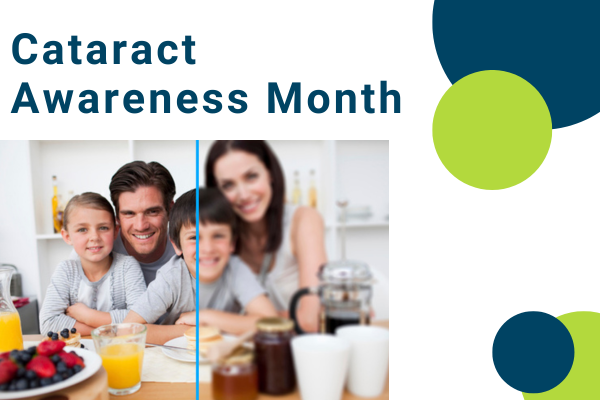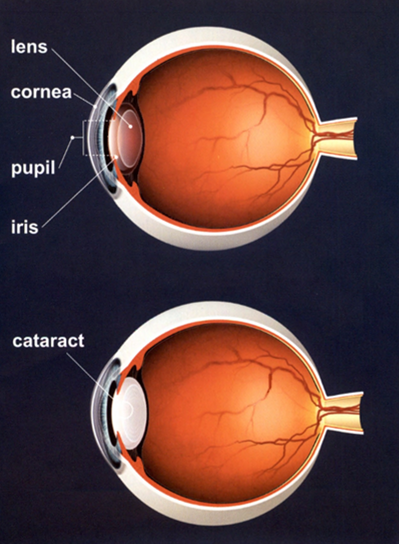June is Cataract Awareness Month
By Holly Herring • Jun 01, 2024

Blog Content
What are cataracts?
A cataract clouds the lens of the eye, steadily causing loss of vision. The lens transfers light to the retina at the back the eye where images are formed, allowing us to focus on objects both near and far.
 What are the symptoms of cataracts?
What are the symptoms of cataracts?
- Blurred or cloudy vision
- Colors may seem faded
- Glare
- Poor night vision
- Double vision
- Eyeglass or contact lens prescription changes frequently
- Sunlight or lighting may seem too bright
- Seeing a halo around lights
Cataracts occur when proteins in the lens clump together and begin to cloud a small area of the lens. Images become blurred or distorted because light cannot pass through the lens as well. The cataract may become cloudier over time, steadily making it more difficult to see. The lens is made up of the nucleus (its center), the lens cortex (periphery) and the capsule (membrane that envelops the lens). Any of these parts can contain cataracts.
How are cataracts diagnosed?
To detect cataracts, your eye doctor will place drops in your eyes to dilate your pupils. A thorough eye exam will be conducted to study the crystalline lens of your eye, as well as to check the optic nerves and retina for changes that might be contributing to your vision complaints. Your eye doctor will also perform a tonometry test to measure the pressure inside your eye, which will also diagnose glaucoma, if present.
Will surgery help people with cataracts?
Cataracts do not always require surgery unless they have a significant impact on activities of daily living. Your eye doctor can make the assessment, and if surgery is required, refer you to an eye surgeon who will make the final determination. The good news is that, if determined necessary and appropriate for you, cataract surgery is a safe and effective procedure.
"I had a cataract removed five years ago and though my vision has improved greatly, I still have some vision difficulties. My eye surgeon suggested low vision rehabilitation and since being referred, I have been able to get back much of my normal life. Independence truly is priceless." – Anonymous Envision Vision Rehabilitation Center patient
Cataract removal is one of the most common types of surgery. There is also good evidence that maximizing vision through cataract surgery is a good fall prevention strategy for older adults. Consult your eye doctor to determine if you are a good candidate for cataract surgery.
Who gets cataracts?
Though Americans primarily develop cataracts because of aging, cataracts can occur in adults in their 40s and 50s. However, most cataracts remain small and do not hinder vision during middle age. It is after age 60 that cataracts most often impair vision. By age 80, most Americans either have a cataract or have had cataract surgery. In addition, there is an increased prevalence of cataracts for women.
Other risk factors include:
- Certain diseases, such as diabetes
- Lifestyle behaviors, such as smoking and alcohol abuse
- Prolonged exposure to sunlight
- Prolonged exposure to radiation
- Steroid use
- Obesity
- Poor diet, lack of nutrition
- Fetal exposure to infection, radiation, steroids, alcohol, other abusive substances
Some cataracts are present at birth, and others develop during the first few months or years of life. Some cataracts are inherited, while others are related to metabolic or systemic abnormalities. In many cases, the cause is unknown. In the older child, cataracts are often related to injuries or ocular inflammation related to juvenile rheumatoid arthritis. When visually significant cataracts occur in a child, prompt surgery and rehabilitation are required to maximize visual development. The visual outcome for children with cataracts is much more optimistic now than it was even a few years ago.
How can low vision rehabilitation help me?
If you have vision loss from cataracts or have residual vision loss after cataract surgery due to other eye diseases, you can benefit from low vision rehabilitation, which can help minimize the negative impact of vision loss on daily life. This process begins with a low vision optometric exam to determine the nature of your vision impairment. When this assessment is completed, your doctor will suggest a plan of care that may include use of optical devices, adaptive aids and an individualized low vision rehabilitation plan to help you make the most of your existing vision.
To learn more about comprehensive, multi-disciplinary low vision rehabilitation for people with vision loss, please visit this link or call 316-440-1600.